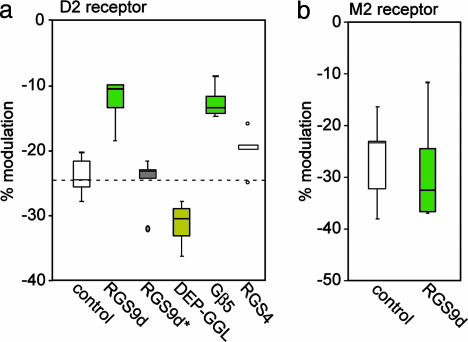Fig. 6.
Summary of the effects of different domains of RGS9-2 on D2 dopaminergic and M2 muscarinic modulation of Ca2+ channels. (a) Under control conditions, D2 dopaminergic stimulation causes an ≈25% decrease in Cav2.2 Ca2+ channel currents as shown in Fig. 4a. Introduction of the RGS domain of RGS9 results in a 50% decrease in D2-dopaminergic modulation of Ca2+ channels, by increasing the rate of Gi turnoff (see also Fig. 4c). RGS4 has no significant effect, demonstrating that this effect is specific to RGS9. Application of an RGS9 construct that is catalytically inactive, RGS9d*, fails to alter the D2 receptor-mediated modulation of Ca2+ currents. Introduction of the DEP/GGL domain of RGS9 (10 μM) antagonizes endogenous RGS9-2 and increases the impact of D2 receptor activation on Ca2+ channel currents. Introduction of Gβ5 decreases the ability of dopamine to modulate Ca2+ current as well as RGS9d, suggesting stabilization or recruitment of endogenous RGS9-2 to the membrane. (b) RGS9d does not modulate M2 muscarinic receptor-mediated signaling to Ca2+ channels, thereby demonstrating receptor-specific regulation by RGS9d. The box plot summary (see Fig. 5) of the current amplitude in control conditions and in the presence of RGS9d (n = 6, P < 0.05, Kruskal-Wallis ANOVA) is shown.

